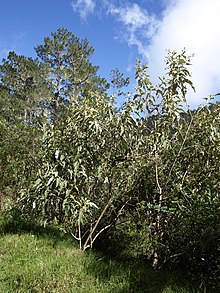
Buddleja is a genus comprising over 140 species of flowering plants endemic to Asia, Africa, and the Americas. The generic name bestowed by Linnaeus posthumously honoured the Reverend Adam Buddle (1662–1715), an English botanist and rector, at the suggestion of William Houstoun. Houstoun sent the first plants to become known to science as buddleja to England from the Caribbean about 15 years after Buddle's death. Buddleja species, especially Buddleja davidii and interspecific hybrids, are commonly known as butterfly bushes and are frequently cultivated as garden shrubs. Buddleja davidii has become an invasive species in both Europe and North America.
Buddleja jamesonii is a species endemic to southern Ecuador, where it grows in moist, protected ravines and borders of tussocks at elevations of 3,000 – 4,000 m. The species, first named and described by Bentham in 1846, is now threatened by habitat loss. The specific name commemorates the Scottish botanist William Jameson (1796–1873) who collected in Ecuador.
Buddleja lanata is a species endemic to Ecuador where it grows on dry, windy plateaux amid grasses and bracken at elevations of 1,150 – 2,700 m. The species, first named and described by Bentham in 1845 is now threatened by habitat loss.
Buddleja lojensis is a species endemic to the Loja region of southern Ecuador, and Piura in Peru, where it grows on mountains, savannahs and scrub, notably near streams, at elevations of 1,600 – 2,550 m. The species was first identified and described by Norman in 1982.

Sabal domingensis, the Hispaniola palmetto, is a species of palm which is native to Hispaniola and Cuba.
Buddleja bullata is a variable species endemic to the Andes, from Venezuela south through Colombia and Ecuador to Peru, at elevations of 1,800–3,600 m, where it grows on stream beds and in the remnants of montane forest. The species was first described and named by Kunth in 1818.
Buddleja cardenasii is a species endemic only to the region of Cochabamba in Bolivia at an altitude of around 3,000 m. The species was first described and named by Standley in 1935.
Buddleja grandiflora is endemic to the marshy fields and river margins of southern Brazil, and adjacent areas of Argentina and Uruguay. The species was first described and named by Chamisso and von Schlechtendal in 1827.
Buddleja hatschbachii is a rare species found only in the wet ravines and rock slopes flanking the east side of the planalto of southern Brazil. The species was first described and named by Norman and Smith in 1976.
Buddleja interrupta is a species endemic to the dry valleys and roadsides of northern Peru at altitudes < 2600 m. The species was first described and named by Kunth in 1818.
Buddleja iresinoides is a species of flowering plant in the family Scrophulariaceae. It is endemic to the rocky hillsides and stream banks of Bolivia and northern Argentina at altitudes from 300 to 1500 m. The species was correctly identified as a Buddleja and named by Hosseus in 1924.
Buddleja longifolia is a species now restricted to remnants of montane forest in Loja, Ecuador, and northern Peru at altitudes of 2100 – 2600 m. The species was first described and named by Kunth in 1818.
Buddleja longiflora is a rare species endemic to one small area of Brazil, growing in fields high on the Serra do Caparaó at an altitude of 2400 m. The species was first described and named by Brade in 1957.

Buddleja megalocephala is a species endemic to Guatemala, in the Central Highlands, the Sierra de los Cuchumatanes, and Mt. Tacana on the border with Mexico, where it grows in open areas associated with evergreen cloud forest at elevations of 2700 – 4,000 m. The species was first named and described by Smith in 1897.
Buddleja nitida is a species endemic to much of Central America, from southern Chiapas in Mexico south to the Sierra de Talamanca in northern Panama, where it grows on limestone slopes, in cloud forest, in clearings and pastures at altitudes of 2,000 – 4,000 m. The species was first named and described by Bentham in 1846.

Buddleja racemosa, commonly known as the Wand Butterfly Bush, is endemic to the southern edge of the limestone Edwards Plateau in Texas, United States, from Austin to Rocksprings, growing around streams, creeks and springs at elevations of 250 – 750 m. The plant was first named and described by John Torrey in 1859.

Buddleja sessiliflora, commonly known as Rio Grande butterfly-bush or tepozán, native to southern Arizona and the lower Rio Grande Valley of Texas in the United States as well as much of central and northern Mexico excluding the Chihuahua Desert and Baja California Sur. The shrub grows in thorn savannah, forests, riparian zones, along roadsides and in disturbed areas from sea level to 2,800 m. The species was first named and described by Kunth in 1818.
Buddleja soratae is a rare species endemic to one small area of Bolivia around Sorata, growing along forest edges at altitudes of 2,700 – 3,200 m; it was first described and named by Kraenzlin in 1913.

Cubanola domingensis, or campanita, are small trees in the family Rubiaceae—which includes coffee, among other genera—endemic to the Dominican Republic. The plant is known for its downward-facing, trumpet-like blossoms.
Buddleja subcapitata is a small shrub discovered in 2003 by Liu and Peng in Sichuan, China, growing alongside a road bordering forest in Yanbian County at an elevation of 2,200 m. First described in 2004, this putative species was not included in Leeuwenberg's study of Asiatic and African buddleja published in 1979.







